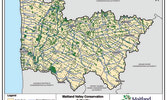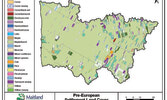By Lisa Boonstoppel-Pot
The number of tree species in Huron County’s forests is “catastrophically low” reveals a condensed report of the Forest Health Project released April 9.
“Most of our trees are upland and downland Maples,” says Erin Gouthro, who has been working in drainage, wetland, aquatic and terrestrial management as a Watershed Ecologist with the Maitland Valley Conservation Authority since 2013. “Maple trees have always historically been the dominant tree species in this watershed but a significant drop in other species has left Maples as the only prevalent tree species.”
Gouthro is currently leading a watershed-wide health assessment of the MVCA’s aquatic and terrestrial systems. Her findings were, in many ways, terrifying with regard to the future of forests in Huron County. She shared them at the April meeting of Huron County’s Water Protection Steering Committee
Forest cover in Huron County has decreased from 16.5 per cent in 2000 to 16.09 per cent in 2020, which amounts to 57,679 total hectares of forested land. Between 2015 to 2020, 207 hectares of forested land was lost. North Maitland had the most total forest loss. Land conversion to agriculture was the leading contributor of forest loss.
Back when the country was covered with forests, they would have been multi-structural with different levels in the canopy. There would have been a “super canopy” of trees like tall white pines which would have been so wide, you could not wrap your arms around them. Like a shelving unit in a house, all these canopy levels created complexity in the forest, something today’s forests struggle with. “Our canopies are homogenized. We do not see a four-structure canopy. Ours are two-structured.” Gouthro explained that canopy complexity and lack of it is a “broad signal” of forest health that needs to be documented to be used as a baseline for future monitoring of the county forests.
Good news is that the basal size of trees is slightly increased which refers to the diameter of the tree and their footprint over the landscape. Then this good news was dampened with knowledge that the understory is getting slightly worse. “We aren’t really sure why,” admitted Gouthro.
Regeneration is another concern. To analyze regeneration, forest tree scientists drop a one-metre grid and identify all the tiny trees in the grid to get an idea of the future forest. It was discovered that most of these tiny trees are ash, with very few maple trees in many forests.
“I have been in maple forests with no maple regeneration,” said Gouthro. “Zero is zero. With only ash regenerating, could that mean the end of forests in Huron County?” she asked. The problem with regenerating ash is as soon as they get large enough (10 centimetres), ash borers infest the tree and kill it. Overall, ash trees accounted for 45 per cent of all seedlings counted. Red maple were five per cent, sugar maple 13 per cent and black cherry four per cent.
Downed woody debris (DWD) is another issue. “It blew out the threshold,” said Gouthro. With all the debris, will forests now emit more carbon than capturing it? This debris also forms mats which is ideal for plants like wild raspberries but they further block the ability of new trees to generate amongst the DWD.
Looking at other forest health signals, Gouthro noted:
● Spring ephemerals: (wildflowers that appear in early spring then disappear such as Trout lily, Oxalis, Hepatics and Bloodroot) are still on the landscape which is a good signal. However, the invasive Garlic mustard which thrives in disturbed areas destroys spring ephemerals
● Pollinators: There are 13 species of wild bumble bees and Gouthro says some of these native bumble bee species are almost extirpated, but added more bee counts and research is being done this year to collect data
Following Gouthro’s talk, the Mayor of Central Huron, Jim Ginn, said in his woodlots, he does see maple, hickory, hackberry and oak regenerating. “To me, woodlots are always changing and a maple stand does not always stay a maple stand.”
Gouthro acknowledged they did see hickory and oak and other trees regenerating but believes there are too few mature stands of these trees to create mass regeneration due to the “cutting pressure” they take. “Most of the woodlots I see just have a flush of ash,” she said.
It’s a signal that really worries her. “How can we get a diversity of regeneration? Can we help it? Do we need to help it? Or is it just part of the cycle?” Goutro said she sees some forests that are very well-managed where owners replant a variety of species. Her worry is how to educate other landowners so they can be better stewards of their forests because logging the bush and creating an ash thicket to grow is not promising for the future health of forests.
For Gouthro, this was an important point of discussion and generated much discussion as well. Dave Pullen, Huron County’s Forest Conservation Officer, agreed that to add diversity to a forest, there needs to be a good seed source nearby. He has seen forests with large cherry trees create an influx of cherry tree seedlings, for instance.
Pullen said for landowners concerned about the future of forests, the best thing they can do is get “good advice. Don’t sell to the first logger who comes down your laneway.” The problem is that biological problems in forests are combined with a current economic pressure and that is creating a “perfect storm” as landowners log bushes or destroy them to create more farmland.
Gouthro added that having a good database is critical to the future of forests as well. “We need to take stock of where we are to elucidate trends and problems and give that information to landowners,” she said. “Monitoring and assessment also provide a foundation of information that can be used throughout time to evaluate change across various time intervals — important because forests exist at a scale that spans many human lifetimes. Data in turn becomes a kind of living memory to hand on to future generations,” states the actual report.
There was a little bit of friendly tension between Pullen and Gouthro as they debated the best approach to forest management with Gouthro finally saying “foresters need to work with ecologists because we see signals in forests that foresters do not recognize because they are not trained to see it. I love foresters and we need to work together from the ground up to work on the whole system.”
For example, new research about spring ephemerals has revealed that these tiny, disappearing flowers take up nitrogen first thing in the spring and as they die down, they release it back into the soil for budding baby trees. “Spring ephemerals are the nursery plants for young trees,” she said.
There is much more information in the actual report which is well worth reading for every landowner. As part of the conclusion of the Forest Health Study report, it was stated:
“If the forests in the Maitland are to have a future, thereby providing their life-giving services to our communities, our perspective must shift. We must stop thinking that whatever influence we have on forests is minor and they’ll simply grow back. The 2021/2022 forest demonstrates the opposite. Under certain disturbance regimes forests don’t grow back, rather, they transform to low-grade invasive plants that halt forest regeneration and destroy habitat for other native forest species.” ◊



